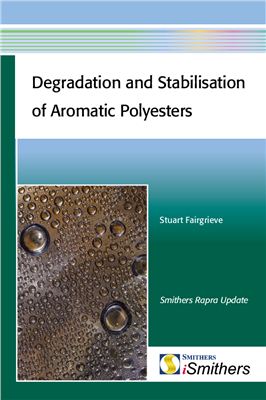Smithers Rapra Technology, 2009. - 280 pages.
This book provides a comprehenisve survey of the degradation and stabilisation processes specific to aromatic polyesters, including thermal, thermo-oxidative, chemical, light and radiation degradation and stabilisation. Current knowledge of all these aspects is discussed and analysed, and some suggestions made as to further studies which might advance the subject. Materials covered include well-known polyesters such as poly(ethylene terephthalate) and poly(butylene terephthalate), through the less well-known poly(alkylene naphthalate)s and liquid crystalline polyesters, to new substances such as poly(trimethylene terephthalate). Also covered are the various means of chemically recycling aromatic polyesters into their starting materials and/or other useful chemical feedstock, including current research into improvements in chemistry and economics of such processes, and information on commercial enterprises carrying out such recycling. With over 1000 references to papers and patents, this book provides both a highly detailed source of information on the degradation and stabilisation of aromatic polyesters in itself, and a useful starting point for further study of this topic both by academic and industrial workers in this field. Those researching or manufacturing aromatic polyester formulations for use in fibres, films, packaging, automotive applications and engineering applications will find much to interest them here. A companion volume on the degradation and stabilisation of aliphatic polyesters, with coverage including degradable materials and polyesters manufactured from renewable resources, is currently in preparation.
This book provides a comprehenisve survey of the degradation and stabilisation processes specific to aromatic polyesters, including thermal, thermo-oxidative, chemical, light and radiation degradation and stabilisation. Current knowledge of all these aspects is discussed and analysed, and some suggestions made as to further studies which might advance the subject. Materials covered include well-known polyesters such as poly(ethylene terephthalate) and poly(butylene terephthalate), through the less well-known poly(alkylene naphthalate)s and liquid crystalline polyesters, to new substances such as poly(trimethylene terephthalate). Also covered are the various means of chemically recycling aromatic polyesters into their starting materials and/or other useful chemical feedstock, including current research into improvements in chemistry and economics of such processes, and information on commercial enterprises carrying out such recycling. With over 1000 references to papers and patents, this book provides both a highly detailed source of information on the degradation and stabilisation of aromatic polyesters in itself, and a useful starting point for further study of this topic both by academic and industrial workers in this field. Those researching or manufacturing aromatic polyester formulations for use in fibres, films, packaging, automotive applications and engineering applications will find much to interest them here. A companion volume on the degradation and stabilisation of aliphatic polyesters, with coverage including degradable materials and polyesters manufactured from renewable resources, is currently in preparation.

